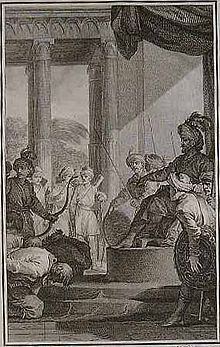 | ||
Child's War was a war between the English East India Company and the Mughal Empire of India which lasted from 1686 to 1690.
Contents
Background
In 1682 the English East India Company sent William Hedges to Shaista Khan, the Mughal governor of Bengal, in order to obtain a firman: an imperial directive that would grant England regular trading privileges throughout the Mughal empire. The company's governor in London, Sir Josiah Child, then interfered with Hedges's mission, causing Mughal Emperor Aurangzeb to break off the negotiations. After that Child started a war with the Mughals.
Events of the war
Admiral Nicholson was sent out in 1685 with twelve ships of war, carrying 200 pieces of cannon and a body of 600 men, to be reinforced by 400 from Madras. His instructions were to seize and fortify Chittagong, for which purpose 200 additional guns were placed on board, to demand the cession of the surrounding territory, to conciliate the Zamindars, to establish a mint, and to enter into a treaty with the ruler of Arakan. But the fleet was dispersed during the voyage, and several of the vessels, instead of steering for Chittagong, entered the Hooghly, and being joined by the Madras troops, anchored off the Company’s factory.
The arrival of so formidable an expedition alarmed Shaista Khan, and he offered to compromise his differences with the English; but an unforeseen event brought the negotiation to an abrupt close. Three English soldiers, strolling through the marketplace of Hooghly, quarrelled with Mughal officials, and were severely beaten. After that the English admiral opened fire on the town and burnt down 500 houses.
In 1686 new negotiations started in Chuttanutty which the Mughals prolonged till their troops could be assembled to attack the English encampment, and English commander Job Charnock retired with his soldiers and establishments to the island of Ingelee, at the mouth of the Hooghly River. It was a low and deadly swamp, covered with long grass, without any fresh water. In three months one half of the English troops were dead from disease.
In 1688 an English fleet was employed for blockading the Mogul harbours on the western coast of India and ships with pilgrims to Mecca were captured. After that Emperor Aurangzeb decided to resume negotiations with the English. However, the Company sent out reinforcements commanded by Captain Heath who on his arrival disallowed the treaty then pending and proceeded to Balasore which he bombarded and burnt. He then sailed to Chittagong; but finding the fortifications stronger than he had anticipated, landed at Madras.
After that Emperor Aurangzeb issued orders for the extirpation of the English, and the confiscation of their property. The English possessions were reduced to the fortified towns of Madras and Bombay.
In 1689 the strong Mughal fleet from Janjira commanded by the Sidi Yaqub and manned by Mappila and Abyssinians firmly blockaded Bombay. After a year of resistance, the English surrendered, and in 1690 the company sent envoys to Aurangzeb's camp to plead for a pardon. The company's envoys had to prostrate themselves before the emperor, pay a large indemnity, and promise better behavior in the future. The emperor withdrew his troops and the company subsequently re-established itself in Bombay and set up a new base in Calcutta.
Aftermath
Sir Josiah Child's war with the Mughal Empire began when he captured Mughal ships and ended when the English were obliged to conclude peace with the Mughal Emperor Aurangzeb in 1689. The effects of this conflict continued to be observed until the year 1703.
